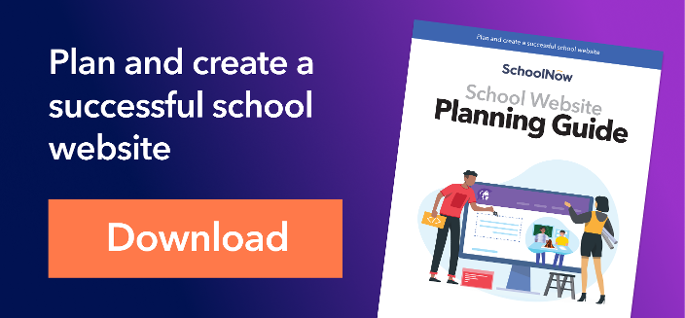A custom school website versus one built using themed design templates is a choice that’s becoming a little easier these days, thanks to web accessibility and ADA compliance. Website templates or custom design for schools. Which will it be for you?
That's right – federal regulations are making it easier on schools. (smiling). Well, when it comes to better serving those in your school community with disabilities, the requirements being adopted by U.S. government to follow a new web accessibility standard just may make the choice between custom and templates a no brainer.
Many school districts still prefer to go the full custom route. Greater design flexibility is usually at the heart of those districts seeking a custom website. Many CMS providers, SchoolNow included, are steering school clients to use themed design templates, for they offer not only cost and surprisingly wide design choices, but make it easier for schools to comply and keep up with the new federal guidelines for web accessibility.
Design for one, design for all
One great design outcome of making school websites ADA compliant is that is has forced both template designers and custom web designers to examine their basic design approach. The design elements that contribute to making a website fully accessible to those with disabilities in fact make a website more accessible to all.
Web content factors like text size, color contrast, descriptive titling, headers, clear calls to action, table formatting and other web page elements are all priorities for web accessibility. These and other factors give web designers and content managers a beautiful common ground that yields web content that works for everyone.
So, website providers who offer custom website design, ready-to-use templates or both must now take into account this new set of rules that will make for better overall design.
Don’t equate many overused “Wow” factors on a website with truly beautiful, effective design. A website can be your school’s most popular touchpoint, so it should be beautiful and reflect all the great things going on, but not for the sake of other key mandatories that include: ease of use and navigation, loading speed, mobile friendliness, and, of course, ADA compliance.
To give you a hand, I’ve put together the pros and cons of templates and custom design that you can consider when you are making the choice, and help you avoid the common mistakes of school website design.
A case for school website templates...
First, I want to say I am a fan of templates if they are high quality – and this is coming from a designer. Depending on what is at stake, templates can provide a better ROI than investing a lot of money in custom design. They also can provide the assurance that your content is much more likely to be fully web accessible and ADA compliant – if, in fact, they’re set up that way. The key is: the templates have to be designed well.
Templates are a good fit when:
1. Speed is of the essencePrebuilt templates will eliminate a lot of the upfront design process and build of the website. It can mean having something up in two months compared to four. It is also important to mention templates require minimal debugging or tweaks.
2. Limited resources
There are many communication and technical requirements that need to lay the groundwork and not to mention your school is not in the business of managing custom web design.
3. Lacking content
If you just have a few pages and a calendar, it may not be good idea to go with custom if you don't have the resources or cannot commit to the developing content required to feed the beast.
4. No competition
If you’re not ‘competing’ with other schools and just trying to make the community happy, a template may be a good choice. You will not have to worry about another school using the same template if that occurs.
5. Choice of templates
All templates are not created equal. In fact, templates are typically a product of a company that does custom work and makes templates for the budget-friendly offering. The quality of the templates and flexibility can be a major factor in whether you choose this option. A good template is designed on best practices for good website design. Do your homework when comparing templates, and make sure they’re ADA compliant, or else your district could be facing stiff fines and negative PR.
6. A good investment in the future
Another benefit of using templates is that many CMS providers are continually updating their ever-expanding library of ADA-compliant themes. You’re not locked in to your current theme. You can change themes, navigation, headers, footers and widgets any time you like. Templates assure your website will stay current with school website design best practices and remain on the right side of federal regulations.
Other considerations when choosing templates
Ready to go. Be careful not to get into a template that has not been proven yet. Ask for examples from other schools using the template and see how they look and function.
User friendly. As Steve Jobs once said, design it not only how it looks but how it functions. Well he is right, the usability of the template is critical, and it should outweigh many aspect of the design. Make sure the template you use makes it easy for your targeted visitors to use the website effectively.
Easy to customize. You need to ensure that if you want to make changes down the road, you can. I run into schools all the time expressing they are nickel-and-dimed to death on the littlest website changes.
Is custom website design right for your school?
If you are looking to stand out, custom design is a great route. I love a nice custom website when it is done right. If you partner with the right company, they will go through a discovery process, understand your school and deliver a design that can incorporate your brand in story. You are making decisions based on your specification and requirements, not the template that you have chosen.
Custom design is a good fit when:
1. Time is on your side
Good custom design can require a process that can take a while. Keep in mind, you are starting from scratch and there is also a lot of subjective aspects of custom design. Prepare for a lot of going back and forth, revision, tweaks and the complexity of building the code.
2. Healthy budget
Good design takes time and time is an expense. Plan on the price being related to the quality of the design.
3. Not-so-great template choices
If your design company is lacking nice templates and you were planning on using them, it may be best to go the custom route.
4. Brand matters
If you’re in competitive market or you need to leverage a strong brand that has been established, a custom design will allow you to make sure the website design integrates tightly.
5. Custom specifications
If your website is very large, needs complex navigation or other specifications, templates may not provide the flexibility to meet your needs.
Other considerations when choosing a custom design
Planning is critical. Unlike using a template, there is a lot to be considered. For example, do you need a committee to approve the design or how to ensure the custom made website will be properly test considering it is built from scratch.
Not all custom design is great. Just because a company offers custom design does not mean it is going to be at a high caliber or you are going to have their most talented designer that was behind all of the design examples they shared with you. Ask the right questions and talk to customers.
Return on investment. Always weigh how much the investment will be versus the return. While a custom design may look great, you may still be able to achieve the functionality and ease of use for parents and the school community through templates. It is best to have a vision for the entire communication strategy and see what funds work best for what.
Assess all your resources then choose wisely
Deciding what route to go for your school website – using templates or custom design – depends on a lot of factors, foremost of which are resources, time and budget. Remember too that not all templates are created equal, so do you homework and see what the CMS providers are offering – because there are lots of templates out there and lots of differences.
Also, just because it’s a custom-designed site doesn’t mean it’s necessarily better either. I’ve seen many custom websites – for schools and other organizations and businesses – that have major design flaws that drive visitors away, making you think twice about ever returning. And you certainly don’t want that.
Topics: Marketing Communication School Districts Private schools Website design

About the author
As co-founder of SchoolNow, Steve believes behind every great school is great communication. He's on a mission to continue to simplify communications for school administrators and help them boost engagement with parents and the entire school community.
.png?width=64&height=63&name=Group%20(4).png)
.png?width=66&height=64&name=Group%20(5).png)
.png?width=56&height=60&name=Group%20(6).png)
.png?width=66&height=52&name=Group%20(7).png)
.png?width=56&height=56&name=Group%20(9).png)
.png?width=59&height=52&name=Group%20(10).png)


